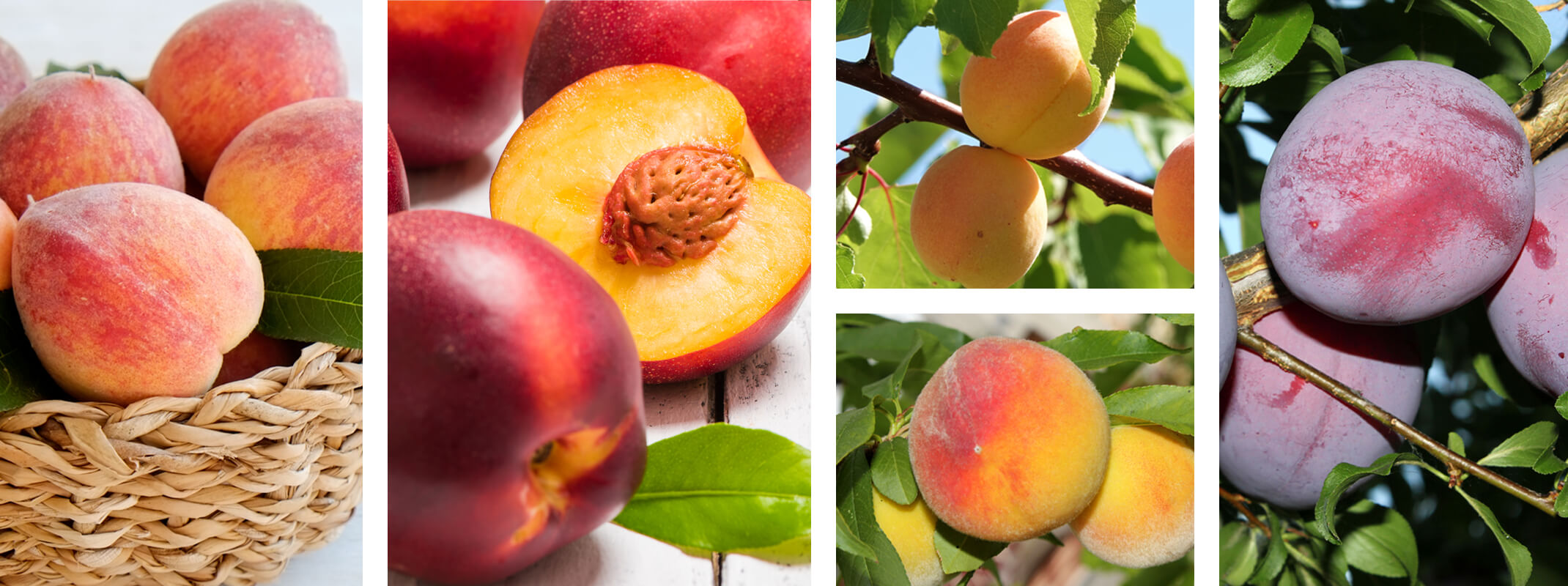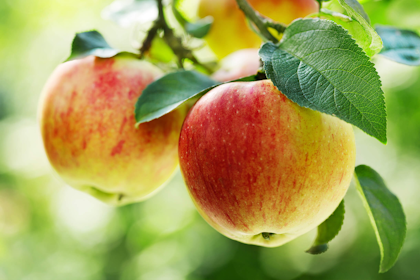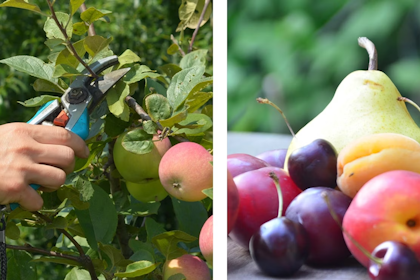Fruit Trees - On Sale!
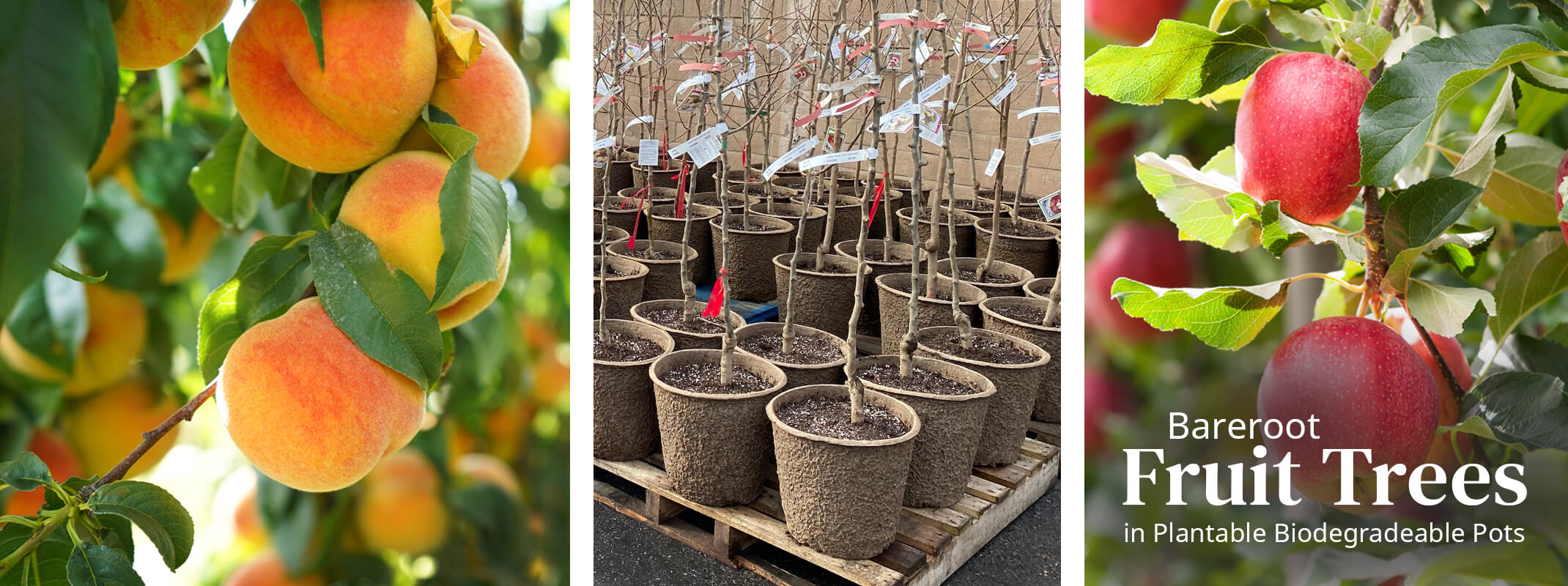
Arrival: around mid-January to February of each new year. Selection may vary by store.
30% off Fruit Trees - While Supplies Last!
- Selection may vary by location
- While Supplies Last - Limited to stock on hand
- Discount not available or prior purchases
Are our potted fruit trees bare root? You bet!
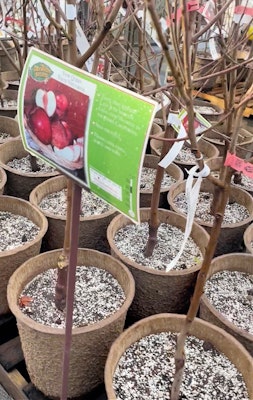 When you stop by SummerWinds, you’ll find our bare root fruit trees already potted in eco-friendly pulp pots. We carefully select only the best varieties from Dave Wilson Nursery and Pacific Groves. The trees arrive as bare roots, and before we offer them to you, we take the time to trim away any damaged branches, pot them with a premium planting mix, and add just the right amount of fertilizer to help set your tree up for success. Potting them up also helps keep the roots moist and protected until you're ready to plant. The pulp pots are biodegradable, so when it’s time to plant, all you need to do is poke a few holes in the pot and plant it right in the ground.
When you stop by SummerWinds, you’ll find our bare root fruit trees already potted in eco-friendly pulp pots. We carefully select only the best varieties from Dave Wilson Nursery and Pacific Groves. The trees arrive as bare roots, and before we offer them to you, we take the time to trim away any damaged branches, pot them with a premium planting mix, and add just the right amount of fertilizer to help set your tree up for success. Potting them up also helps keep the roots moist and protected until you're ready to plant. The pulp pots are biodegradable, so when it’s time to plant, all you need to do is poke a few holes in the pot and plant it right in the ground.
3 Types of Fruit Trees:
Multi-Grafted Trees - 7 Varieties
A multi-graft fruit tree is a tree that has more than one type of fruit grafted onto a single rootstock. This can include different fruit types, like peaches, pears, and plums, or multiple varieties of the same fruit, such as Fuji, Braeburn, and Golden Delicious apples. By grafting several varieties onto one tree, you can enjoy a variety of fruits from the same tree, making it a great choice for small spaces or for those looking to diversify their harvest.
Our Most Popular! Fruit Salad Tree
This is by far our most popular variety and this year we made sure to bring in a huge selection. This incredible tree produces FIVE different fruits on ONE Tree.
Peaches, Apricots, Nectarines and Plums
- Gold Dust Peach - Best early season yellow peach: very high scores for flavor and overall appeal in Dave Wilson Nursery blind taste tests. Semi-freestone ripens mid to late June in Central California, 2-3 weeks ahead of Redhaven. All purpose, superb for eating fresh. Not an early bloomer.
- Independence Nectarines - Bright red skin, firm yellow freestone. Rich flavor, tangy and sweet, one of the best. Consistently very high-scoring in taste tests. Winter and frost hardy, very reliable producer.
- July Elberta Peach - Also called Early Elberta. Reliable heavy crops. Juicy, sweet, very flavorful yellow freestone fruit for canning, freezing, or fresh use.
- Late Santa Rosa Plum - Medium to large, reddish-purple skin, red-streaked amber flesh. Tart-sweet with rich flavor when fully ripe. Harvest about one month after Santa Rosa.
- Blenheim Apricot - All-purpose freestone. Sweet, aromatic, flavorful - the long-time No. 1 apricot in California. Early bloom. Chilling requirement 400 hours or less.
Multi-Graft Espaliered Apple Tree
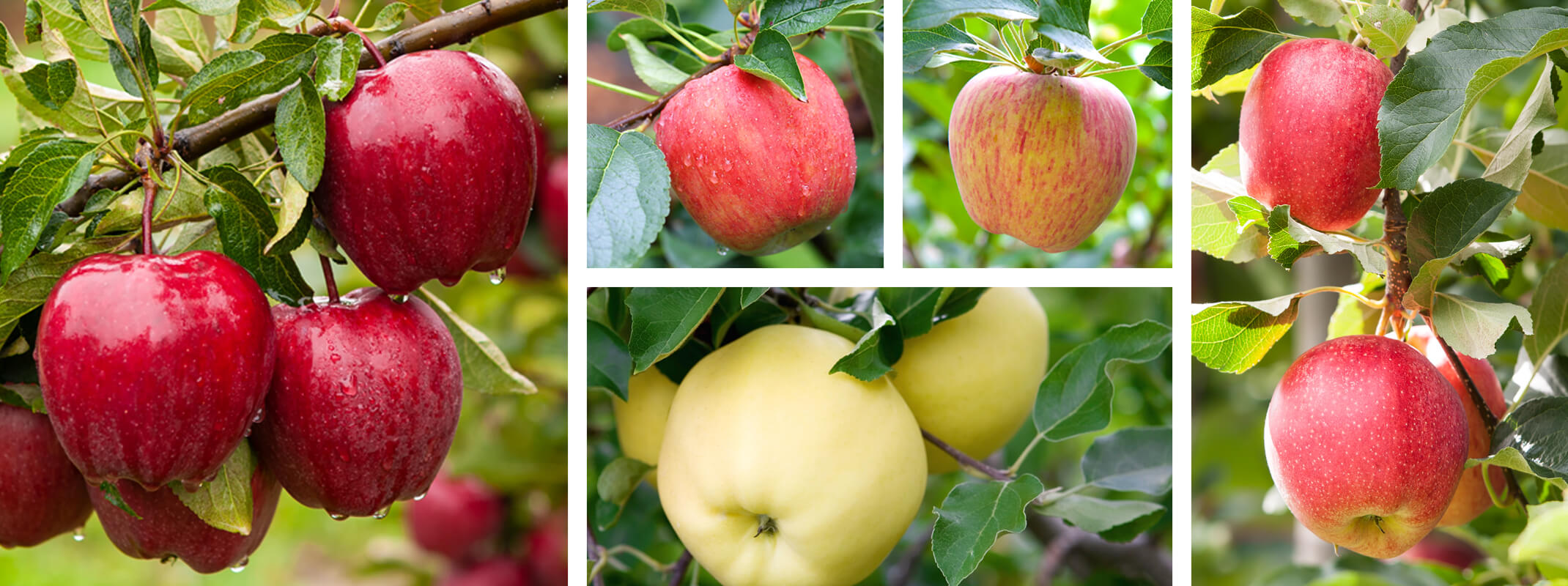
- Braeburn - New, from New Zealand. Superb late season fruit: very crisp and tangy, more flavorful than Granny Smith. Excellent keeper. Green with dark red blush.
- Fuji - Introduction from Japan that quickly became California's favorite apple. Sweet, very crisp and flavorful, excellent keeper. Dull reddish orange skin, sometimes russeted. Excellent pollenizer for other apple varieties. Proven producer in So. Calif. low chill climates.
- Gala - Wonderful dessert apple from New Zealand. Crisp, nice blend of sweetness and tartness, rich flavor. Skin reddish orange over yellow. Early harvest. Good pollenizer for other varieties. Adapted to cold- and warm-winter climates. Chilling requirement less than 500 hours.
- Golden Delicious - Sweet, crisp, superb flavor, even in hot climates. Greenish-yellow with red blush to full red. Dessert/cook, good keeper. 8-10 ft. tree, smaller with pruning.
- Gravenstein - Famous for sauce and baking, also used fresh. Crisp, juicy, flavorful and tart. Early bloom, early harvest. Not a pollenizer for other varieties.
- Red Delicious - Sweet, crisp, flavorful - perhaps the best Red Delicious. Small, compact tree. Good pollenizer for most other apples.
Multi-Graft Cherry Tree
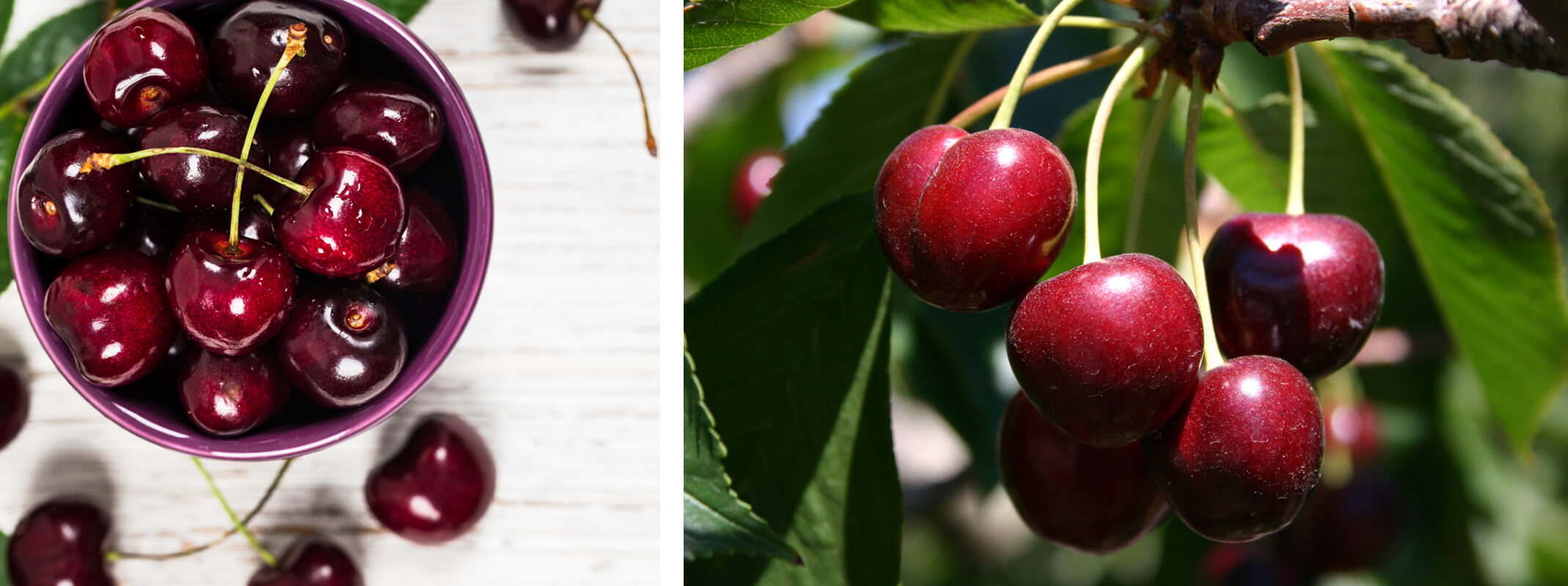
- Black Tartarian - Huge cherries that are bursting with flavor! These juicy cherries are perfect for snacking and baking.
- Bing Cherries - Large and heart-shaped with a firm, meaty, purplish-red flesh and a semi-free stone that is easily removed—making them ideal for fresh eating and preserves.
- Lapins Cherry - Delicious dark fruit nearly one inch in diameter and has purplish red flesh that is firm and sweet.
- Van Cherries - Often compared to the Bing cherry, Van cherries are the most widely planted varietal, but is even sweeter, juicier, crunchier and more flavorful.
Multi-Graft Pear Tree
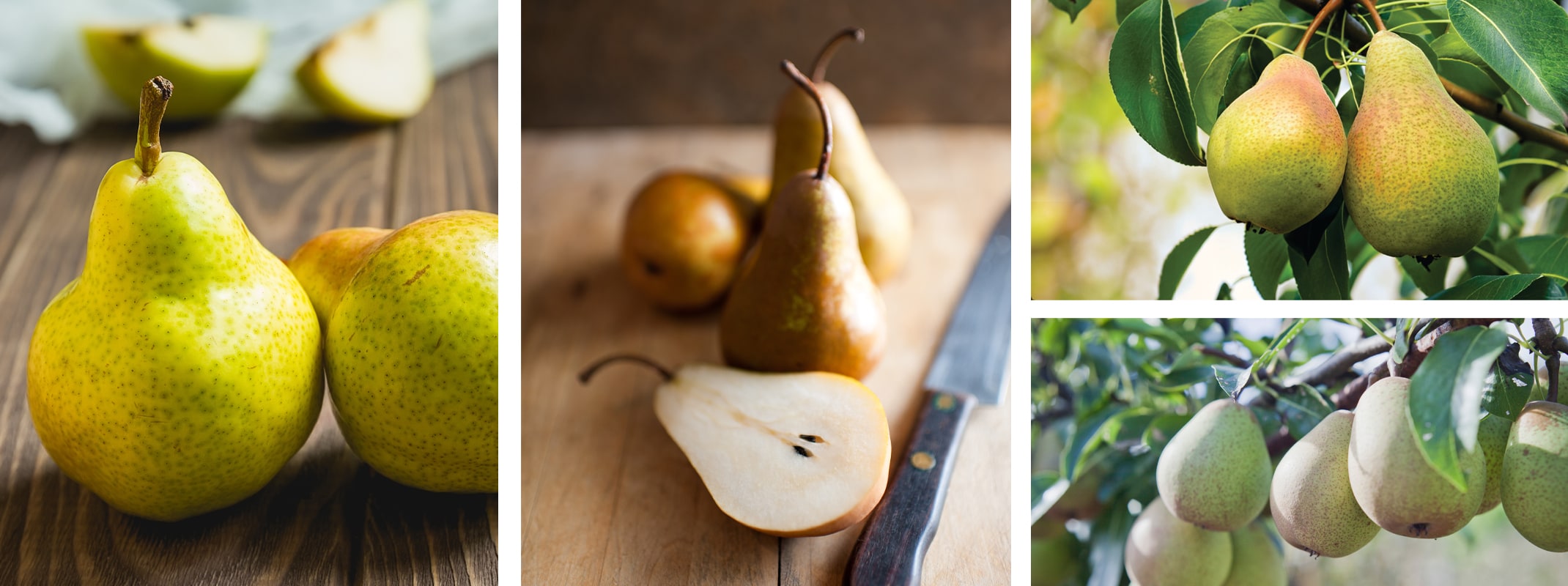
- Comice - This pear is well-known as a premium choice for gift packs. Renowned for its sweetness and aromatic qualities, it boasts a fine texture and superb flavor, ranking among the finest. The Comice Pear is recognizable by its short neck and its greenish-yellow skin, which is often accentuated with a red blush.
- D'Anjou - This variety is large and features a short neck. It is known for its firmness and good quality. Additionally, it has a notable ability to keep well over time.
- Bartlett - Renowned as the world’s most popular pear, known for its juicy sweetness, smooth texture, and distinctively classic pear shape. Ideal for both fresh eating and canning.
- Bosc - This variety is distinguished by its long and narrow shape, and its signature brown skin. It is acclaimed for its superb quality, ranking as one of the best pears. Known for its crisp texture and sweet, spicy flavor, the Bosc pear is excellent for both eating fresh and cooking.
Multi-Graft Pluot Tree

- Flavor King - Taste test winner. Unique plum-apricot hybrid with sensational bouquet and sweet, spicy flavor. Reddish-purple skin, crimson flesh. Naturally small tree. It's an interspecific plum, includes plum and apricot in its parentage.
- Flavor Queen - Exquisite plum/apricot hybrid with candy-like sweet, wonderfully pleasing flavor. Greenish-yellow skin, amber-orange flesh.
- Dapple Dandy - Taste test winner. Ranks with Flavor King Pluot® among the all-time top five best flavored fruits. Creamy white and red fleshed freestone with wonderful plum-apricot flavor. Skin greenish-yellow with red spots, turning to a maroon and yellow dapple.
- Flavor Supreme - Taste test winner. Plum/apricot hybrid with sweet, richly flavored, firm red flesh. Greenish-maroon mottled skin.
Multi-Graft Espaliered Pear Tree
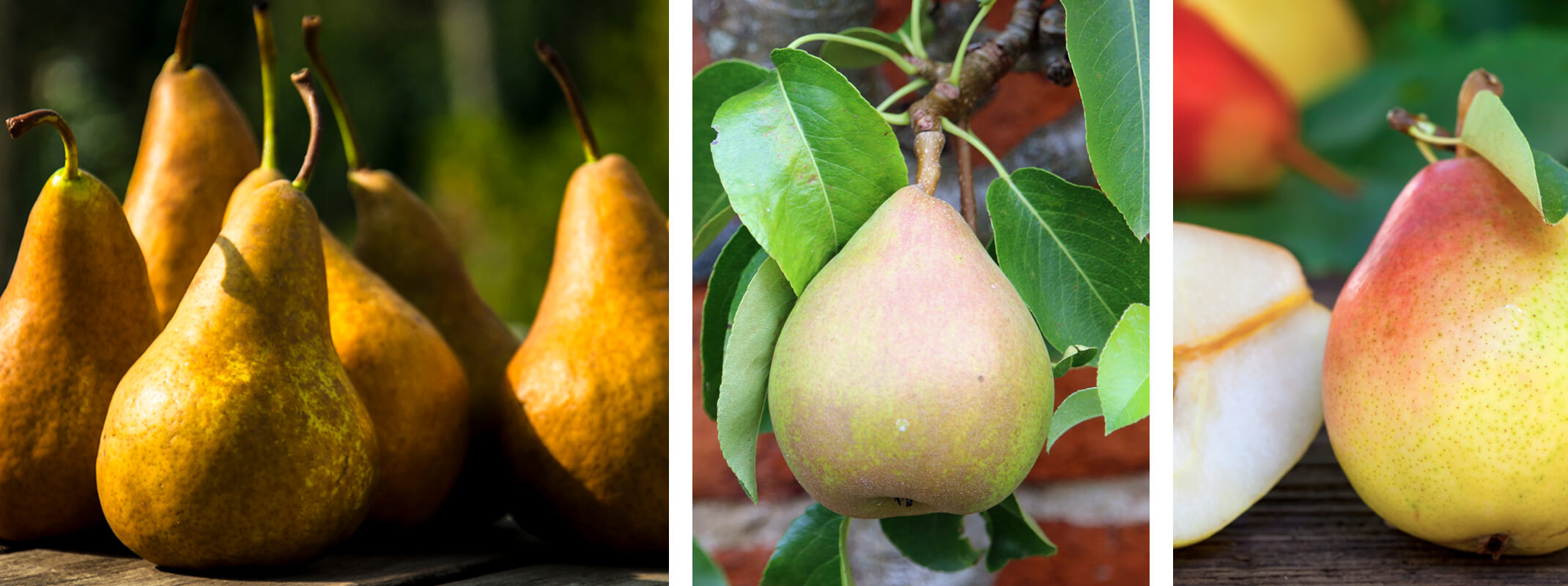
- Comice - The famous gift pack pear. Sweet, aromatic, fine texture, superb flavor and quality - one of the best. Short neck, greenish-yellow skin with red blush.
- Bartlett - World's most popular pear. High quality, tolerates hot summers. Self-fruitful in most climates of Western U.S.
- Bosc - Long and narrow shape, brown skin. Superb quality, one of the best. Use fresh or cooked. Susceptible to fire blight in warm, moist climates.
- D'Anjou - Large, short necked, firm, good quality, keeps well.
- Red D'Anjou - Large, short necked, firm. Stores well, excellent quality and smooth texture. Ripens with D'Anjou around September 1st. Strong full red color is very even, unlike Red Bartlett which has a blushed color. 800 hours pollenized by Bartlett.
- Flemish Beauty - Fruits are large with a rounded shape and have creamy-yellow skin blushed with red.
New at SummerWinds! Multi-Bud Peach-Nectarine "Showy Flowers"
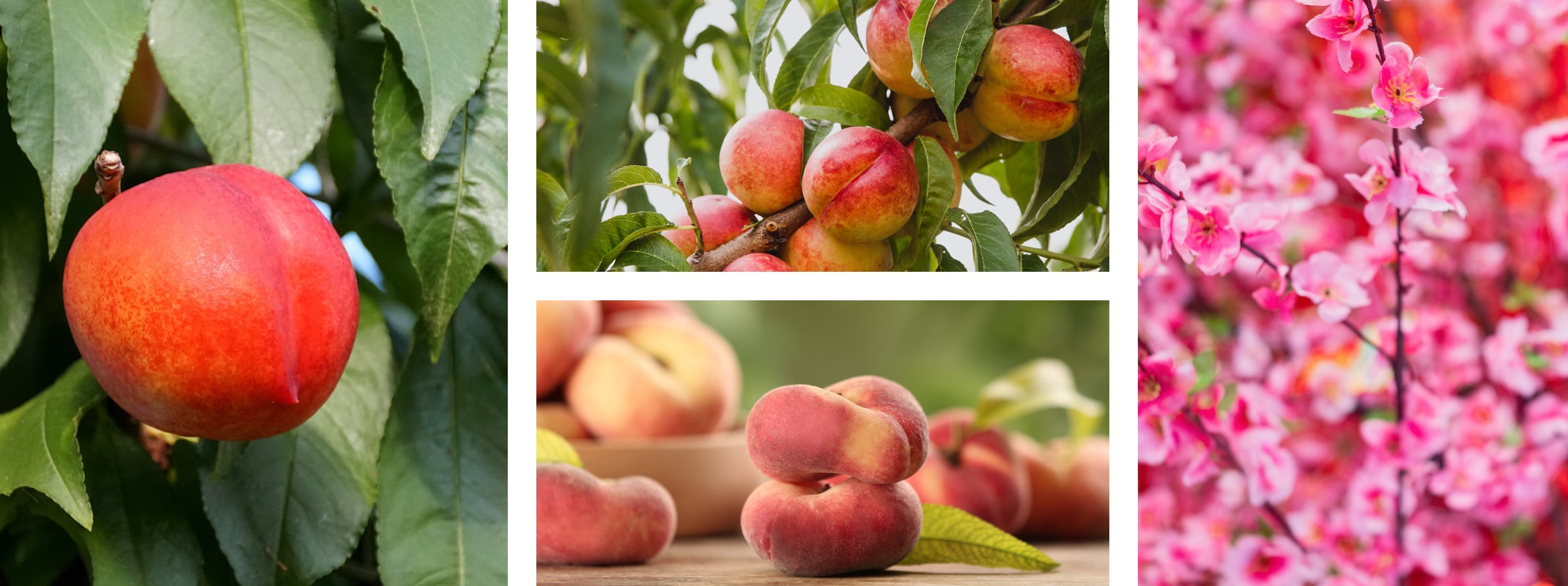
The Multi-Bud Peach-Nect "Showy Flowers" tree is a beautiful, vibrant addition to your garden. This unique tree is grafted with a selection of premium varieties, including Fantasia Nectarine, Saturn Peach, Red Baron Peach, Mid-Pride Peach, and Double Delight Nectarine—all budded onto robust Nemaguard rootstock. These varieties offer an exceptional blend of flavor, texture, and stunning spring blossoms that will turn your garden into a visual feast. Whether you're looking to enjoy the sweet nectarines or the juicy peaches, this tree provides a versatile and showy display of fruit.
Semi-Dwarf Tree
A semi-dwarf fruit tree is a smaller-sized tree that makes it perfect for gardens with limited space, while still offering a bountiful harvest of some of the tastiest fruit around. These trees typically reach 8 to 12 feet in height. Pruning seasonally will help keep these trees at a manageable height.
Apples - 6 Varieties
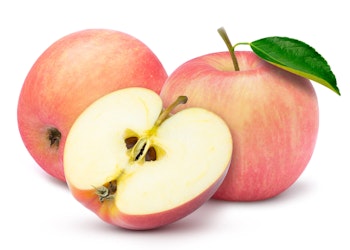 Dorsett Golden Apple Tree
Dorsett Golden Apple Tree
-
A superbly sweet apple variety, ideal for regions with mild winters. This tree produces apples with a firm texture and a rich, sweet taste, reminiscent of Golden Delicious. It's an excellent choice for an early season sweet apple. Requires only 100 hours of chill. It is self-pollinating.
- Originating from Japan, this variety has become a favorite in California. Known for its sweet, extremely crisp, and flavorful apples, it is also an excellent variety for long-term storage. The apples have a dull reddish-orange skin, occasionally with russeting. They mature around mid-September. This tree is an outstanding pollinator for other apple varieties. It has a low chill requirement of under 500 hours and is self-pollinating.
- A delightful dessert apple hailing from New Zealand. It offers a crisp texture and a pleasing balance of sweet and tart flavors, with a rich taste. The apples feature a reddish-orange skin over a yellow base. They are ready for early harvest, typically 2 to 3 weeks before Red Delicious. This tree is an effective pollinator for various other apple varieties. It's versatile, adapting well to both cold and warm winter regions. Requires less than 500 chilling hours and is self-fruitful.
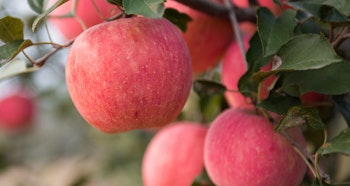
- Originating from New Zealand, this variety produces large, late-season, green apples suitable for various uses. They are known for their crisp texture and tart flavor and are excellent for long-term storage. This tree flourishes in hot climates and requires a long summer, with a chill requirement of 400 hours. It has an extended blooming period, making it a great pollinator for other apple varieties. Self-fruitful.
- A winter-resistant tree developed by the University of Minnesota. Its fruit is known for being crisp and juicy with a delightful aromatic flavor. The apples display a striped red over yellow appearance and have excellent storage qualities. They typically ripen in mid-August. This tree is effectively pollenized by Gala, Granny Smith, Empire, McIntosh, and Red Delicious apples.
- This apple variety, hailing from Western Australia, thrives in hot climates. It produces very crisp apples with a sweet-tart taste and a unique flavor, and they store well. The skin turns reddish-pink over green when ripe, and the white flesh is resistant to browning. Harvest in Central California begins in late October, roughly three weeks after the Fuji variety. The tree is self-fruitful and requires 300-400 chill hours.
Apricots - 3 Varieties
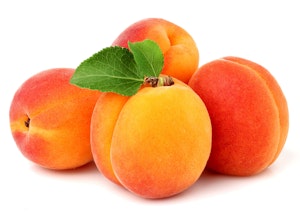 Blenheim (Royal) Apricot Tree
Blenheim (Royal) Apricot Tree
- A versatile freestone variety, renowned for being the top choice in California for a long time. It offers sweet, aromatic, and flavorful apricots. This variety blooms early and is typically ready for harvest in late June in Central California. It requires 400 hours or less of chill time and is self-fruitful.
- Highly favored by apricot enthusiasts for its exceptionally rich taste and aroma. It is a dependable producer of fruit, suitable for both fresh consumption and canning. This variety requires 600 chill hours and is self-fruitful.
- This variety boasts a stunning white flesh with vibrant orange-over-yellow skin, offering a visually striking contrast. Often hailed as one of the finest-flavored apricots, the White Knockout delivers a creamy smooth texture and a rich, sweet flavor that will have you reaching for more. Ripening in early June, these apricots bring a perfect balance of sweetness and tang, making them a standout in any garden.
- This is a hybrid of apricot and plum, featuring white flesh. The medium-sized fruits offer an incredible, very sweet, and juicy flavor. They typically ripen from early to mid-July. This variety is self-fruitful and requires about 400 chill hours.
Jujube - 3 Varieties
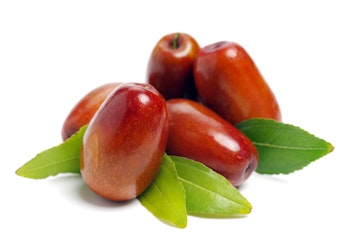 GA866 Jujube Tree
GA866 Jujube Tree
-
Popular Variety! Often referred to as the "Chinese date," this tree produces outstanding two-inch elongated fruits known for their exceptional sweetness and apple-like flavor. These jujubes ripen in mid-autumn. While partly self-fruitful, they can also be pollinated with another jujube variety for optimal yield. Requires about 200 chill hours. Suitable for USDA Zones 5-9.
-
This tree produces round-shaped fruits that are larger than the Lang variety. When fully ripe in early Fall, they turn reddish-brown, dry, and wrinkled, offering a sweet and chewy texture, similar to dates. The tree itself is attractive and easy to cultivate, being hardy, drought-resistant, and largely free from pests and diseases. It thrives in long, hot summer conditions and has a very low chilling requirement. Self-fruitful.
-
This variety produces round fruits that are smaller than those of the Li jujube. The flesh is sweet and crunchy. The tree itself matures early and is known for being hardy, drought-resistant, and largely immune to pests and diseases. It flourishes in long, hot summer conditions and has a very low chill requirement. While it is partly self-fruitful, cross-pollination can enhance fruit production.
Cherries - 4 Varieties
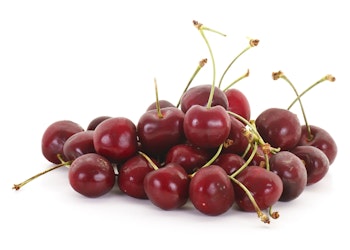 Popular Variety! Royal Rainier Cherry
Popular Variety! Royal Rainier Cherry
-
This variety produces large yellow cherries with a bit more red blush compared to traditional Rainier cherries. They are acclaimed for their excellent flavor, having won taste tests. The tree blooms in the late midseason and the cherries are ready for harvest in the early midseason, typically between May 18 and June 4.
-
This self-pollinating variety, requiring a low chill period, is known for producing large, crimson-red cherries. These cherries are celebrated for their sweet and slightly tangy flavor, combining a rich, juicy texture that makes them a favorite for fresh eating. Harvest typically occurs from early to mid-May.
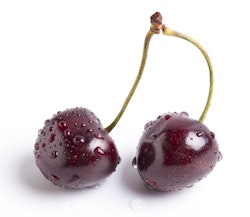
-
Produces large, heart-shaped cherries with firm, meaty, purplish-red flesh. The semi-free stone inside is easily removable, making these cherries perfect for both fresh consumption and for use in preserves.
-
Yields delectable dark cherries, almost one inch in diameter, with firm, sweet, purplish-red flesh.
Nectarines - 7 Varieties
Arctic Sprite Miniature White Nectarine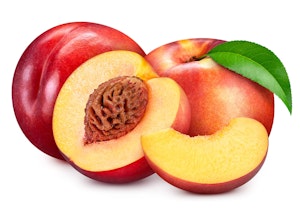
-
This tree is an ideal partner to the early-ripening Arctic Babe. It produces white-fleshed, freestone nectarines with a tangy-sweet flavor, maturing in the late midseason. The spring bloom is spectacular. Its small, naturally dwarf stature makes it very manageable for thinning and harvesting, and its size also simplifies covering for protection against spring frost.
-
This tree offers a sensational combination of outstanding flavor and visual appeal. It consistently produces some of the best-tasting yellow nectarines, complemented by magnificent double pink blossoms. The fruit, featuring a dark red skin and a freestone nature, is notably sweet with an unusually rich taste, scoring very high in taste tests. Additionally, it's a heavy-bearing tree, promising an abundant yield.
-
This well-liked tree produces large, yellow, freestone nectarines. The early harvest yields firm, ripe, and tangy fruit, while the later harvest brings out a sweet taste with a rich flavor, earning high marks in taste tests. Expect to harvest in late July or early August in Central California. It requires 500 hours or less of chill time and is self-fruitful.
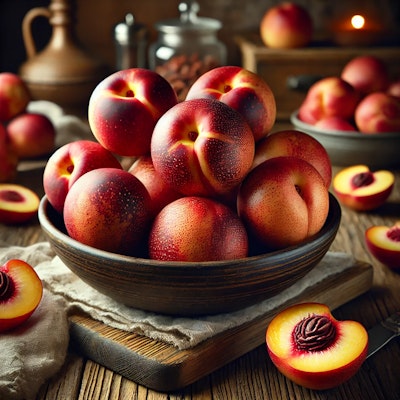
-
A standout mid-season nectarine, the Freckle Face offers a full-bodied flavor that shines from firm to soft ripe stages. Its perfect balance of sweet and tangy notes makes it a favorite among nectarine lovers. The fruit features a stunning dark red skin, dotted with sugar spots, while the orange-red freestone flesh is beautifully marbled with deep red veins that run throughout. A true treat for the senses and brings a burst of flavor and color to any garden.
- Renowned for its top ratings in Dave Wilson Nursery's taste tests, this tree produces very large, firm nectarines. The fruit features a freestone nature and white flesh, boasting an excellent balance of acidity and sweetness with a rich, complex flavor that appeals to connoisseurs. The nectarines have a unique skin coloration, blending dull red with cream. They typically ripen in mid-July in Central California, requiring about 650 chill hours. The tree is self-fruitful, not needing another for pollination.
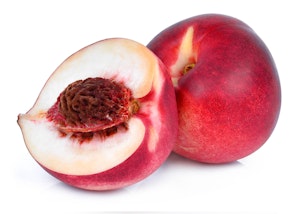
-
This variety offers sweet, highly flavorful yellow freestone nectarines with attractive red skin. Expect ripening from mid-June to early July in Central California. The tree is strong and vigorous, growing up to 6 feet tall. Recognized as one of the best self-fruitful miniature nectarines, it requires 400 hours or less of chill time and is self-fruitful.
-
A proven winner in taste tests, this tree produces sweet and juicy white freestone nectarines. It has an early season harvest, typically occurring in late June in Central California, which is 2-3 weeks ahead of the Babcock peach. This variety has long been a favorite in Southern California. It has a low chilling requirement of 250-300 hours and is self-fruitful.
Peaches - Varieties
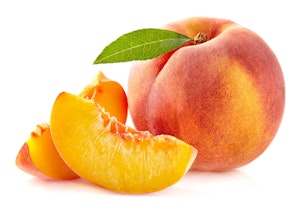
Frost Peach
-
Proven to be resistant to peach leaf curl based on 10-year trials at Washington State University. This variety offers delicious yellow freestone peaches with a slight red blush over greenish-yellow to yellow skin. It's a heavy bearer, excellent for both canning and fresh eating. The peaches ripen in July. The tree features showy pink blossoms in spring and requires 700 chill hours. It is self-fruitful.
-
This tree produces distinctive white-fleshed fruits with a unique sunken center, resembling a doughnut. The fruit is sweet with a mild flavor, often described as having an almond-like taste. Expect ripening in late June to early July in Central California. It has an estimated chilling requirement of 200-300 hours and is self-fruitful.
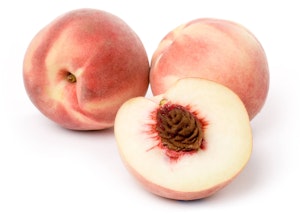
-
This variety produces sweet, yellow freestone peaches with a rich peach flavor. The tree, reaching up to 5 feet in height, is a heavy bearer. The fruits are typically ready for harvest in early to mid-July in Central California. An excellent choice for home orchards, it requires 400 hours or less of chill time. While partly self-fruitful, it may sometimes bear more fruit with a pollenizer as it can be shy-bearing.
-
This tree is known for its reliable and heavy yields. It produces juicy, sweet, and very flavorful yellow freestone peaches, ideal for canning, freezing, or fresh consumption. It requires 400-500 chill hours and is self-fruitful.
-
This tree produces large fruits that ripen in Central California from mid to late June, about two weeks ahead of Honey Babe. The peaches are delicious, firm, and yellow freestone, with an attractive red over orange skin. The tree is vigorous, growing up to 6 feet tall. It requires 400 hours or less of chill time and is self-fruitful.
-
Ideal for enthusiasts of white peaches, the Sauzee Swirl is a novel saucer-shaped ("donut") peach developed by Zaiger Genetics. It features attractive white flesh with red marbling and a flavor that is irresistibly moreish.
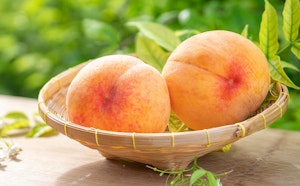
-
This variety yields delicious yellow freestone peaches, maturing about two weeks after Elberta. It is more vigorous compared to other miniature peach trees. Blooming later in the season, it is less prone to frost damage. The tree, which grows to a height of 5-6 feet, features showy blossoms. It requires 500 hours or less of chill time and is self-fruitful.
Pears - 2 Varieties
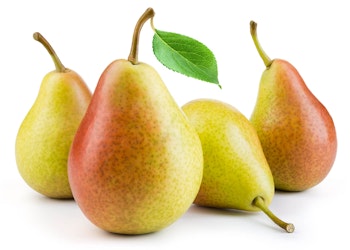
Shinseiki Asian Pear Tree
-
This variety is known for its juicy, sweet, and refreshing fruits, with a crispness akin to an apple. It's easy to grow and the pears have a good storage life. Expect to harvest them in late July or early August in Central California. The pears have a bright yellow skin and the tree is vigorous and heavy-bearing, often starting by the 2nd year. It requires 250-300 chill hours and is self-fruitful.
-
Recognized as the most popular pear variety worldwide. This tree produces high-quality fruit in early to midseason and can tolerate hot summers. It requires 500-600 chill hours. In most Western U.S. climates, it is self-fruitful.
Persimmons Tree - 2 Varieties
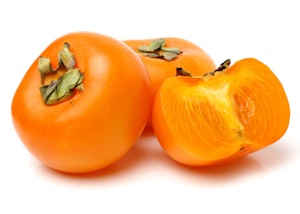 Popular Variety! Fuyu (Jiro) Persimmon
Popular Variety! Fuyu (Jiro) Persimmon
-
This tree produces medium-sized, flat-shaped fruits that remain crunchy even when ripe, and are non-astringent. Suitable for both cool and hot climates, it's a hardy and attractive tree with minimal pest issues. The fruits are typically harvested in the fall. It requires about 200 chill hours and is self-fruitful.
-
This tree bears large, acorn-shaped fruits with a deep orange-red hue. A hot summer climate is essential for the fruit to mature. The flavor is sweet and rich; however, it is astringent until fully soft and ripe. To ripen, mature fruits can be frozen and then thawed. This tree is not only productive but also serves as an ornamental addition to any space. It requires 200 chill hours and is self-fruitful.
Plums, Pluots, and Pluerry - 5 Varieties:
Burgundy Plum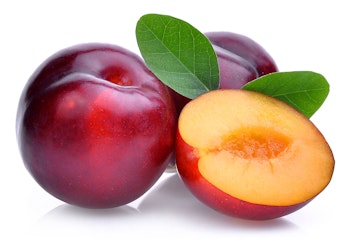
-
This variety produces plums with maroon-colored skin and semi-freestone flesh. The fruit is notably sweet with minimal tartness, offering a very agreeable, mild flavor that has received high ratings in taste tests. Enjoy an extended picking period from mid-July to mid-August in Central California.
-
A favorite among plums in California and Arizona, this tree produces juicy, tangy, and flavorful fruit. The plums have a reddish-purple exterior with amber flesh that's streaked with red. They typically ripen in late June in Central California. With a low chill requirement of 300 hours, the tree is self-fruitful.
-
Renowned as a taste test winner, this variety is held in high regard alongside Flavor King and Flavor Supreme Pluot® varieties for its exceptional flavor, as confirmed by Dave Wilson Nursery tastings. The fruit is freestone with creamy white and red flesh, offering a delightful combination of plum and apricot flavors. The skin starts as greenish-yellow with red spots and matures into a maroon and yellow dapple pattern. Typically harvested in August in Central California, this tree requires 400-500 chill hours and is suitable for USDA Zones 5-10.
-
Splash Pluot features small to medium-sized, red-orange fruit with very sweet, vibrant orange flesh. Consistently ranking among the highest-scoring varieties at Dave Wilson's formal fruit tastings, this variety is celebrated for its delightful flavor. The round to heart-shaped fruit is perfect for eating fresh, drying, or incorporating into desserts. Once established, the upright tree produces large crops. It thrives with 400 chilling hours or fewer and is pollinated by Santa Rosa plum or Flavor Grenade Pluot®
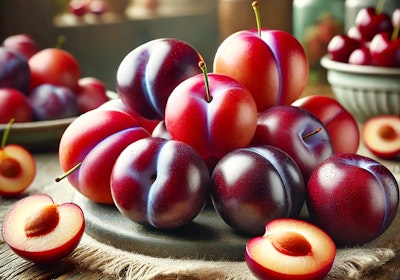
-
The Sweet Treat Pluerry™ is a delightful hybrid, combining the sweetness of cherries with the vibrant summer zing of plums. This unique interspecific variety, predominantly plum and cherry, is much larger than a cherry but smaller than a typical plum. The fruit hangs on the tree for over a month, allowing you to enjoy the colorful, ornamental beauty of the tree as well as its delicious fruit. Reaching peak ripeness at the end of July, this prolific variety is a must-have for your garden. Tested as 46MB583, it’s pollinated by Santa Rosa plum, Burgundy plum, and Flavor King Pluot®. Requires 200 to 300 chill hours.
Prunes - 2 Varieties
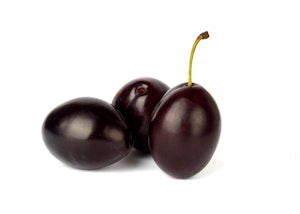 Italian Improved Prune
Italian Improved Prune
- This tree bears large fruits with a deep purple skin and a freestone nature. The fruits have a rich and very sweet flavor when they reach full ripeness. They are versatile, being excellent for fresh consumption, drying, or canning. The tree itself is vigorous and notably cold hardy. It features a late blooming period and yields its harvest in late summer. It requires about 800 chill hours and is self-fruiting, meaning it doesn't need another tree for pollination.
-
This tree bears plums with reddish-purple skin and greenish-yellow flesh, known for their exceptional sweetness. The fruit is versatile, suitable for both fresh consumption and canning. Notably, it has a lower chilling requirement compared to other European prune and plum varieties, needing about 550 chill hours. The tree is self-fruitful.
Ultra Dwarf Fruit Tree - Available Now!
An ultra-dwarf fruit tree is a very compact variety that grows to about 3 to 4 feet tall, making it perfect for small spaces or containers. In contrast, a semi-dwarf fruit tree is slightly larger, reaching 8 to 12 feet, and is ideal for those who need more space for growth but still want a manageable size. Both produce full-sized fruit, but ultra-dwarfs are much more compact and easier to handle.
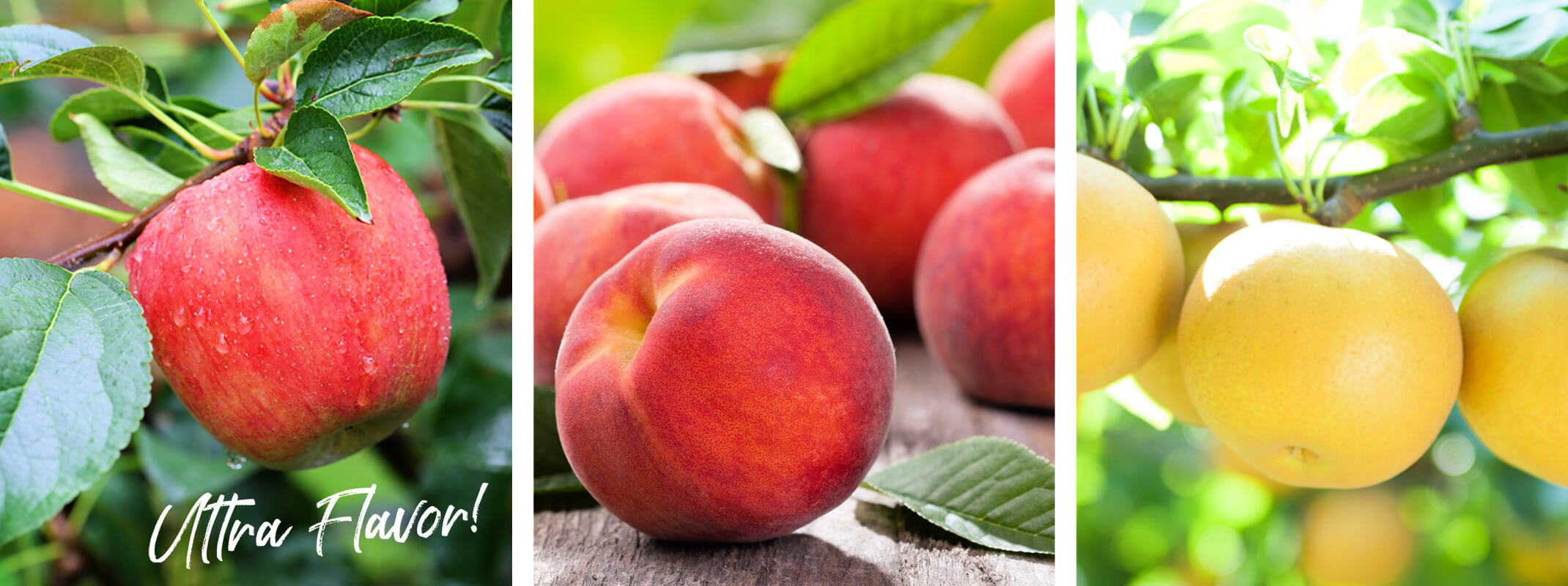
It’s not uncommon for today’s home gardener to have a confined or smaller space to work within. Many of us are even limited to a balcony or patio space to grow our favorite fruits and veggies, eliminating the idea of growing a fruit tree. The ability to grow an Ultra Dwarf Fruit Tree is now an option. Reaching anywhere from 5’ to 8’ tall, these small trees produce abundant, standard-sized fruits that taste far better than anything you can purchase at your local grocery store.
Selection Includes:
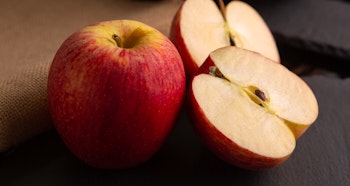
Honeycrisp Apple
Honeycrisp apples are indeed a remarkable variety, cherished for their large size and distinctive fluorescent red skin. They offer a very sweet yet slightly tart flavor profile and boast a commendable storage life of over three months when kept in suitable conditions. In the spring, their blossoming period is marked by striking pinkish-white flowers that add ornamental value before yielding the visually appealing and flavorful fruit. Known for their exceptional crispness, Honeycrisp apples are versatile, perfect for fresh consumption, culinary use, and even cider making, and they store well in cool environments.
- Mid to late-Harvest
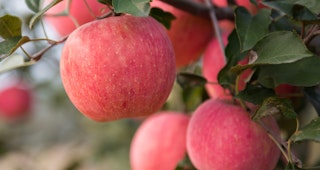
Fuji Apple
A top pick among home gardeners, this superb variety, a cross of the Delicious, hails from Japan and bears fruit with a similar coloration to the Delicious apple. The fruit's flesh is remarkably firm, with a satisfying crunch, ample juiciness, and a hint of acidity, contributing to its excellent taste and impressive longevity after harvest. The trees themselves are vigorous, resilient, and prolific, producing abundant yields that store exceptionally well.
- Fruit ripens September to October
- Late-Harvest
- Self-fertile
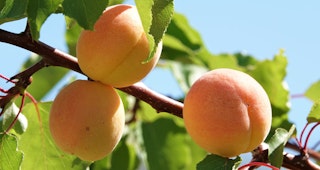
Blenheim Apricot
The Blenheim Apricot is a medium-sized, oval-shaped fruit with a rich, deep yellow hue. It is highly regarded both for fresh eating and for its excellent qualities in canning. It's known as the most favored variety among home gardeners. Many who preserve this type of apricot traditionally leave the pit in during the canning process. Additionally, the Blenheim Apricot tree serves as a valuable pollinizer for other trees in the garden.
- Fruit ripens May to mid-June
- Early to mid-Harvest
- Low chill
- Self-fertile
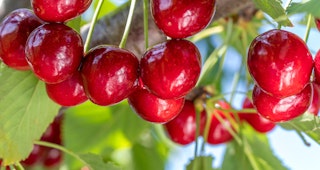
Bing Sweet Cherry
Bing Sweet Cherries are acclaimed as some of the finest sweet cherries grown in the Western States, known for their very large size and superb quality. When ripe, their skin boasts a dark burgundy-red shade. These cherries are firm to the touch, juicy, and sweet, making them highly desirable. They are also celebrated for their excellent shipping qualities and are favored in fresh market sales. Very firm, sweet fruit. Ripens 4-5 days after Bing. Tree is a late bloomer. Otherwise, just like Bing.
- Mid-Harvest
- Self-fertile
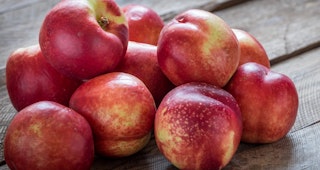
Snow Queen Nectarine
The Snow Queen Nectarine is lauded as one of the finest nectarine varieties available. It thrives with a low chill requirement, making it suitable for warmer climates. The fruit it produces is quite large, with a pale skin that carries a subtle russet blush. Its white flesh is freestone, meaning the pit easily separates from the fruit, and it is known for being especially juicy and having a fine texture. For the best flavor, it is recommended to pick the nectarines while they are still firm and allow them to ripen indoors.
- Fruit ripens mid-June
- Early-Harvest
- Self-fertile
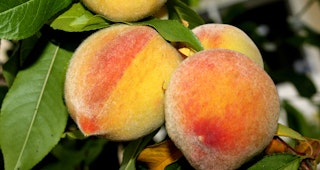
Early Alberta Peach
The Early Alberta Peach, specifically the Gleason Strain, is recognized for its superior quality and is highly sought after by commercial canning industries. This variety produces large fruits with an oblong shape, displaying a golden-yellow hue that is more vivid than that of the Elberta peach, often with minimal to no red blush.
- Fruit ripens late-June to early August
- Mid-Harvest
- Self-fertile
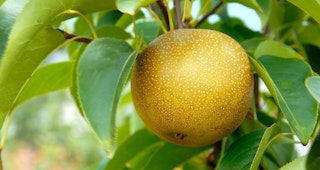
20th Century Asian Pear
The fruit known as "pear-apple" offers a delightful blend of a pear's flavor and sweetness with the crisp texture and robustness of an apple. They reach their optimal taste when allowed to ripen on the tree. Their suitability for fruit salads has earned them the nickname "salad-pears."
- Fruit ripens mid-August
- Mid-Harvest
- Self-fertile
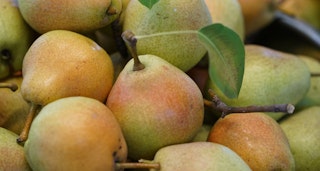
Kieffer Pear
Keiffer Pear Trees produce medium to large pears that are yellow with a red blush. The fruit's white flesh is notably crisp and coarse in texture. This variety is known for its late bearing of fruit and has a low requirement for chilling, making it suitable for warmer climates. The pears are excellent for culinary uses, including cooking and canning, and they have a good shelf life.
- Fruit ripens September to mid-October
- Late-Harvest
- Self-fertile
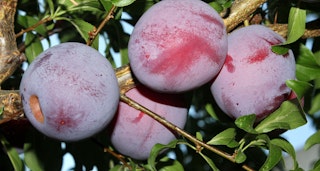
Santa Rosa Plum
Among the Japanese plum varieties, this one stands out as one of the largest and most aesthetically pleasing. It boasts a yellow flesh that is both delicious and fragrant, coupled with a juicy consistency. It's highly recommended for home gardens due to its round, consistently sized fruit that transports well. The plums have a striking dark crimson skin and the tree serves as an excellent pollinator for other plants in the garden.
- Fruit ripens June to early July
- Early-Harvest
- Self-fertile
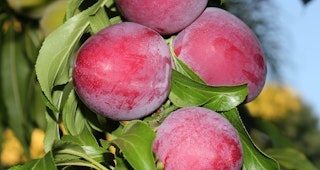
Weeping Santa Rosa Plum
This variety offers fruit of the same high quality as the Santa Rosa plum, presented on a small, elegantly weeping tree. It is quite decorative and well-suited for container planting. The tree blooms with delicate white flowers that remain visible for over two weeks. Additionally, this variety is notably resistant to disturbances from birds and squirrels.
- Fruit ripens June to early July
- Early-Harvest
- Self-fertile
The Essentials
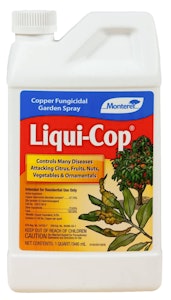
Liqui-Cop Copper Fungicidal Garden Spray
Contols many diseases attacking citrus, fruits, nuts, vegetables and ornamentals.
- Monterey
- Quart
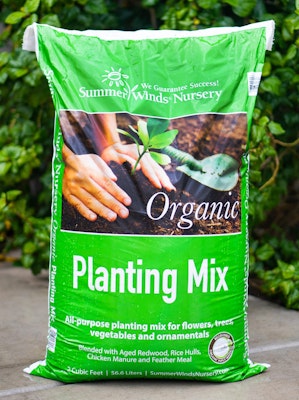
SummerWinds Planting Mix
All-purpose planting mix for flowers, trees, vegetables and ornamentals.
- Organic
- 2 cu ft. Bag
Liquid Copper Fungicide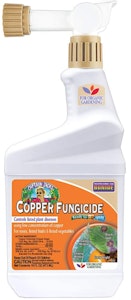

Controls powdery mildew, black spot, downy mildew, early blight and other plant diseases on roses and on fruits and vegetables.
- Bonide - Ready to Spray
- 16 oz.
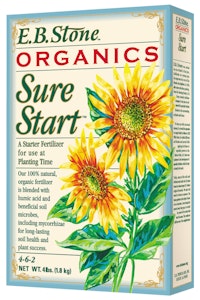
Sure Start Fertilizer
A starter fertilizer for use at planting time. This 100% natural, organic fertilizer is blended with humic acid and beneficial soil microbes, including mycorrhizae for long-lasting soil health and plant success.
- E.B. Stone Organics
- 4 lb.
Citrus & Fruit Tree Food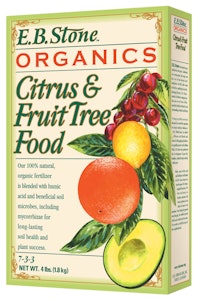
For long term care of your fruit tree, we recommend E.B. Stone's Citrus and Fruit Tree Food.
- E.B. Stone Organics
- 4 lb.
- 100% Natural and Organic Fertilizer
- Long Lasting & Non Burning Formula
- Feed every 6-8 weeks during the growing season
Looking to add fresh, homegrown fruit to your Bay Area garden but worried about space? Think again! With the right planning, you can grow fruit trees in even the smallest spaces. From delicious peaches and plums to compact citrus varieties, there’s a fruit tree for every garden. In this blog, we share 5 reasons why fruit trees are the perfect addition to your landscape—no matter how limited your space may be.
Get essential tips for caring for your fruit trees! This guide covers planting, watering, pruning, and pest management, plus the best times to plant and how to fertilize for healthy growth. Learn when to thin and harvest your fruit for the best results. Ready to grow productive fruit trees in your Bay Area garden? Start here!

